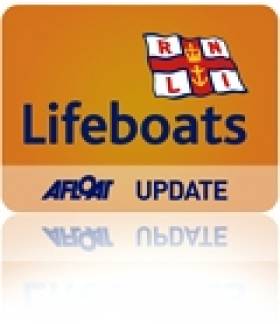Displaying items by tag: RNLI Dun Laoghaire Station
St. Patrick's Day Dalkey Island Snorkel Raises Funds for RNLI
#DALKEY ISLAND SNORKEL - More than 100 participants took part in the St. Patrick's Day Dalkey Island snorkel fundraiser event in aid of the RNLI, where the local Dun Laoghaire lifeboat RNLB Anna Livia was hove to off Coliemore Harbour, writes Jehan Ashmore.
Some two hours after high-tide this morning the snorkelers set off from the harbour through Dalkey Sound and made an anti-clockwise circuit of the island.
The circuit took up to an hour to complete and their progress was monitored by a fleet of safety RIBS, with the last participants returning to the harbour around noon.
A crowd gathered overlooking the harbour where fundraising activities took place and it was hoped that the event would raise between €4,000 - €5,000.
The fundraiser was organised by the Marlin Sub Aqua Club on behalf of Comhairle Fó Thuinn (CFT) the Irish Underwater Council. The club was established in 1980 and operates from the Clondalkin Community Sports Centre in west Dublin.
- RNLI
- RNLB Anna Livia
- Dalkey Island
- St Patrick's Day Dalkey Island Snorkel fundraiser
- Coliemore Harbour, Dalkey,Co Dublin
- Dalkey Sound
- RNLI Dun Laoghaire Station
- Marlin Sub Aqua Club
- CFT
- Irish Underwater Council
- St Patrick's Day, Dalkey
- Trent class
- RNLB Ann Livia (1405)
- Comhairle Fo Thuinn
- Dun Laoghaire Lifeboat Station
Dun Laoghaire Replaces Malahide as Relief Lifeboat Base
Dun Laoghaire Harbour has replaced Malahide as the new location for a relief lifeboat base which is to serve the RNLI's Irish Division, writes Jehan Ashmore.
Dun Laoghaire was chosen because of the strategic central location on the Irish Sea. The base benefits the service in providing improved emergency response times and savings on fuel costs. The Severn-class lifeboat RNLB Osier (17-34) has been one of the designated relief lifeboats to be based in the marina.
An added attraction in choosing Dun Laoghaire is the ability to haul lifeboats out of the water for maintenance and repairs. The boat-lift hoist and transport trailer facility is operated by MGM Boats Ltd and is conveniently sited within the boundary of the marina. In addition the RNLI also operate the lifeboat station beside the Carlisle Pier. The station is served by the Trent-class RNLB Anna Livia and a new inshore-lifeboat (ILB) the Realt Na Mara which entered service during the summer.
Related Safety posts
RNLI Lifeboats in Ireland
Safety News
Rescue News from RNLI Lifeboats in Ireland
Coast Guard News from Ireland
Water Safety News from Ireland
Marine Casualty Investigation Board News
Marine Warnings






























































